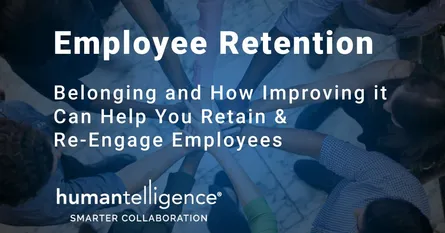
Inclusion belonging

Improve Belonging in the Workplace to Re-engage Employees
- 13 Nov, 2024
- DEIB
Companies continue to struggle to retain talent because leaders don’t understand the real reason why people are resigning -- and part of it revolves around the need to improve belonging in the workplace. Wonder no more. According to a recent McKinsey study, the top reasons people are resigning have less to do with money, work life balance, or mental health and more to do with inclusivity. One of the top reasons people are resigning is because they didn’t feel a sense of belonging in the workplace. And those employees from traditionally marginalized communities are more likely to say they left because they didn’t feel like they belonged in their organizations. Jeanine Stewart, senior consultant with the Neuroleadership Institute says, “Being surrounded by other human beings doesn’t guarantee a sense of belonging. Belonging actually has to do with identification as a member of a group and the higher quality interactions which come from that. It’s the interactions over time which are supportive of us as full, authentic human beings.” When you improve belonging in the workplace, you will help your team members feel this sense of community, which is important to their fulfillment and to the success of the organization as a whole. Belonging as a Fundamental Workplace Need In his article, Why Belonging Is Such A Big Issue In Business Today, Josh Bersin notes that at work, a sense of “not being included” can be deadly. When people feel left out of meetings, don’t have input on their work assignments, or sense that they have been excluded from decisions or opportunities, they feel stress, anger, mistrust, and anxiety. This, of course, results in turnover problems and ultimately makes the company brittle and underperforming. We need people, and this need is hardwired into our brains. A recent study from MIT found that we crave interactions in the same region of our brains where we crave food, and another study showed we experience social exclusion in the same region of our brain where we experience physical pain. Work at the University of British Columbia found when we experience ostracism at work, it can lead to job dissatisfaction and health problems. In a similar vein, a study at the University of Michigan found when people lack a sense of belonging, it is a strong predictor of depression. In fact, it is an even stronger predictor than feelings of loneliness or a lack of social support. And since we spend so much of our waking lives at work, it only makes sense that belonging at work would be a major contributor to satisfaction and productivity. How to Improve Belonging in the Workplace 1. Focus on Building Community It has never been more important to be intentional about building community in your organization. A sense of community is key to belonging, and a key driver of retention. Be consistent with all company and team gatherings where you share updates and ensure people feel like they are part of the mission. Talk about your organization’s failures and struggles, and celebrate the big and small wins. Make everyone feel like they own a piece of the mission to deepen engagement and commitment. As an employee, embrace groups. Build your friendships with individuals, but also consider joining personal or professional groups with which you feel a common sense of purpose and solidarity. That will help create a greater sense of belonging. 2. Make an Effort to Check on People’s Well-Being Leaders must ensure they spend dedicated weekly one-on-one time to check in on how employees are doing. 1:1s are one of the most important tools at a leader’s disposal to ensure employees feel seen, heard, and feel like they have a place on your team. Be sure to prioritize this valuable time to connect with employees. It’s especially important to use this time to ask colleagues about issues you know impacting their communities. You could also use this time to ask employees why they choose to stay. Ask them what would make them leave. Be prepared to hear something you might not like. And be prepared to take accountability and action on how you and the organization can ensure they feel like they can belong. This is an opportunity to turn the Great Resignation into a Great Awakening. 3. Signal Acceptance When people lack a sense of belonging, they may feel threatened or alone, causing them to withdraw or hold back. When people feel a sense of comfort, they are in the best state for engaging. Colleagues can signal acceptance and help ensure the people around them feel safe, by asking questions, listening and demonstrating focused attention. The start of a meeting can be an opportunity. Choose to take a moment, if you’re leading a meeting, to ask how people are doing and then really listen. If we can’t create belonging through physical closeness in the ways we used to, we can and must think about how we might create that through focused attention and listening. To Improve Belonging in the Workplace, Identify the Need Social belonging is a fundamental human need, hardwired into our DNA. And yet, more than 40% of people say that they feel isolated at work, and the result has been lower organizational commitment and engagement. In a nutshell, companies are blowing it. Businesses in the U.S. spend 8 billion dollars each year on diversity and inclusion (D&I) trainings that miss the mark because they neglect our need to feel included and that try to treat this need as the same for everyone. The truth is, everyone is different, and depending on their background, experiences, personality, and role, the degree to which someone feels the need to belong can differ. The question becomes, how can you identify and determine the needs of your team -- and then improve belonging in the workplace. Using a psychometric-based self-assessment can help you unlock your employees' behaviors, motivators, and ideal work energizers. When you have this kind of data for all of your employees, you can then map your team, and then use the above tactics in a more targeted way -- working to break down barriers you didn’t know where there, better understand others’ perspective, and close gaps -- all of which leads to a more inclusive environment in which individuals feel a greater sense of belonging within their team.